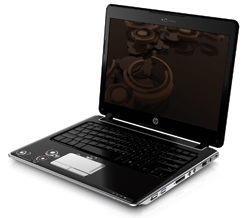AMD Neo, HP dv2 take on both netbooks and notebooks


The platform, previously code-named Yukon, includes the Neo chip and ATI Mobility Radeon graphics. Though it has been described as AMD's netbook solution, Yukon and laptops based on it are really traditional notebooks in terms of features and performance. But because it should allow PC manufacturers to build ultraportables that are thinner and less costly--HP's dv2 will start at $699--it is certain to further blur the already muddied lines between netbooks and notebooks. In effect, it should provide some real competition for both netbooks at the high-end and ultraportables at the low-end.
The first Neo is 1.6GHz single-core processor manufactured at 65nm. (Intel manufactures its desktop and mobile processors using a more advanced 45nm process.) Neo has an average power rating of 15 watts, which makes it suitable for ultraportable notebooks. By comparison, an AMD Turion X2 Ultra has a power rating of 35 watts, which is most AMD-based laptops that you see on Best Buy shelves are bulkier. The Yukon platform also includes either Radeon X1250 integrated graphics or Radeon HD 3410 discrete graphics. In press presentations, AMD said Yukon-based ultraportables will deliver overall performance that is significantly better than Intel Atom-based netbooks but not as powerful as laptops with Intel Core 2 Duo chips and Intel integrated graphics. With a Radeon HD 3410 discrete GPU, a Yukon laptop should be capable of 1080p HD playback and decent 3D gaming.
The Pavilion dv2 has a 12.1-inch LED-backlit display and nearly a full-size keyboard, but is "just under" one-inch thick, and weighs 3.8 pounds, according to the company. It won't be available until April so there are no details on the configuration, but in addition to the 1.6GHz Neo chip, it will include discrete graphics, up to 500GB of storage and the "full range of connectivity options" including wireless WAN. (That last line may be a crack at Apple's MacBook Air, which starts at more than twice the price of the dv2 but is missing some basics such as an Ethernet jack.) Though the dv2 has no internal optical drive, HP will offer an optional external Blu-ray drive.
Despite all the hype about AMD netbooks, products like the dv2 aren't likely to be confused with smaller netbooks with 8.9-inch displays. But Yukon-based ultraportables do make it harder to justify super-sized netbooks with 12-inch displays such as the rumored Asus S121, Dell Inspiron Mini 12 or Samsung NC20 when you can pick up the more-capable Pavilion dv2 for a bit more. And depending on the performance of Yukon, they could also put a big dent in sales of much-pricier ultraportables that use low-voltage and ultra low-voltage Intel dual-core processors.
Though it was nearly lost in the shuffle, HP announced a second new ultraportable earlier today--this one based on existing AMD Turion X2 processors. The Pavilion dv3 has a 13.3-inch LED-backlit display and weighs 4.4 pounds. The larger frame gives it enough elbow-room for internal DVD drive. The dv3 is available immediately and starts at $800 with a 2.0GHz Athlon X2, 2GB of memory, ATI Radeon HD 3200 graphics, a 160GB hard drive and the internal DVD drive. Options on the higher-end configurations include faster processors, more memory, SSDs, a slot-loading DVD, 802.11n and Verizon wireless WAN, and backlit keyboard. For the price, the dv3 stacks up very well to existing 13.3-inch ultraportables.
[Read the AMD press release.]
[Read the HP press release.]